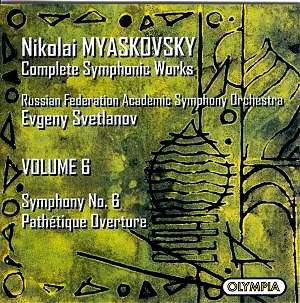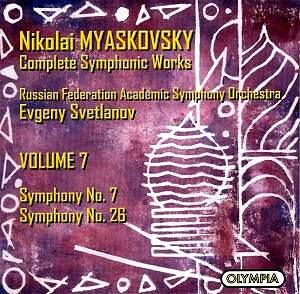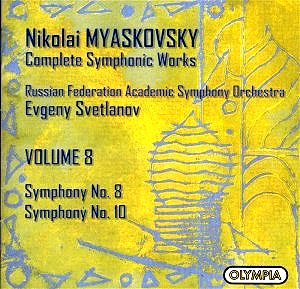I reviewed the first five volumes in this momentous
and musically rewarding project earlier this year. With steadfastness
and no hint of corner-cutting Olympia have since then issued a further
four volumes all of which are reviewed here.
The complete sequence has all the shock of the new.
That said, Svetlanov himself issued, via Records International, a very
limited run (300 units only) of the complete sequence back in 2000.
This Olympia intégrale is however the first generally
accessible production.
In this present batch the world premiere recordings
of symphonies 20 and 26 appear alongside the first ever issue of the
Pathétique Overture.
When Svetlanov went into the concert hall just over
a decade ago it was very much to complete the sequence he had
started back in the 1970s rather than to re-record every symphony. Thus
his small handful of earlier analogue recordings have been interpolated
into this sequence. None of these appear in this quartet of discs.
The discs are laid out with Symphony No. 1 appearing
in Volume 1, No. 2 in Vol. 2 and so on. Thus we find the Sixth Symphony
in Volume 6. Before that 62 minute symphony we come to a work Miaskovsky
wrote to mark the thirtieth anniversary of the Red Army: the determined
Pathétique Overture. After a typically downbeat
introduction comes an equally typical cavalry (or more likely tank)
assault. Rather as in the finale of the Twenty-Sixth Symphony there
are moments hinting towards Tchaikovsky's 1812 but at the zenith comes
a grandly expansive heroic theme in which nostalgia and nobility meet
in a manner worthy of the symphonies. This is very much a concert overture
with the umbrageous mien and foreboding of Berlioz's Les Franc-Juges
and of Rachmaninov's Isle of the Dead. The final five minutes
are rather brash but nothing more than you might find in Liszt and the
effect is moderated by that grand heroic theme (strong - though not
of the high creative quality of those to be found in the 20th, 24th
and 25th symphonies) which rises in brassy Baxian splendour over a vulgarity
that is quaintly Beethovenian and Tchaikovskian.
The towering Sixth Symphony is given a tempestuous,
whipped and fleet-footed reading - furious rather than light-hearted
- the sort of speed you might have expected from Golovanov on an impetuous
day. Would that Svetlanov had found this pacing for his recording of
the Fifth Symphony which lumbers and lingers ineffectually by the side
of Konstantin Ivanov's classic and still supreme version on a long deleted
Olympia (1987 OCD133) - a version to convince you of Miaskovsky's mastery.
It also pales beside the very good Balkanton version (030078, June 1989)
and Edward Downes's Marco Polo on 8.223499. However, back to the Sixth.
This version is up against Järvi's recent DG recording which is
better recorded than this and is not quite as molten. Frankly you will
get on well with any of these. The Dudarova (on a previous Olympia OCD510)
is better than serviceable and well engineered but lacks the imaginative
heft to be found in the other recordings. Oddly enough Dudarova was
in the Ostankino recording studios in July 1992 while Kondrashin was
in the middle of recording the Miaskovsky cycle. Kondrashin's mono Sixth
on Russian Disc (if you can find it) is revered but its mono tracking
and sound quality renders it of historic value rather than being recommendable
in the face of this Svetlanov, Järvi and the still surprisingly
good Stankovsky (Marco Polo). Given that Stankovsky is a degree cooler
than both Järvi and Svetlanov it is between Järvi and Svetlanov.
If you want the work with the choral finale then go for Järvi;
if you are content with the orchestral only version (and the choirís
role is only in the finale and then very brief) then Svetlanov on Olympia
is the one to opt for.
The 25 minute Seventh (in two movements) is
dwarfed by its mighty predecessor. It too rattles cages but the darkling
pages are this time alive with distressed echoes of Ravel's La Valse
and distorted reflections of Tchaikovsky's Fifth. The work opens
in an uncanny image of the start of Bax's Second Symphony premiered
in Boston by Koussevitsky during the mid-1920s. Bass accented strings
shudder, pregnant with bleak tension. The work plunges and charges along.
Relish some thunderously chesty dense string tone at 6.38 in the first
movement! The Sixth has its ineffably nostalgic themes and one of equal
quality is used in the second movement of the Seventh. It is like a
tender memory of childhood - a fragile distortion of Bye Baby Bunting.
It is deployed twice and with most effect at 9.09. It is absorbed within
a black protesting storm of noise and fades into the ticking of the
clock evoked by the harp (a much used instrument in this work). The
work ends with a Ravelian snarl and a lump in the throat.
There are alternative versions of the Seventh. The
1976 recording by Leo Ginsburg and the USSR Radio SO is belligerent,
tender, urgent and imperious but age is beginning to tell and besides
this AAD reissue on a 1980s Olympia (OCD163) is long gone. Still, if
you see it in a secondhand bookshop do pick it up. It plays for 23.30
as near as dammit to Svetlanovís own timing. Halász takes a couple
of minutes longer but has the superbly transparent, lucid and powerful
acoustic of the Slovak Hall on his side though even that is trounced
in terms of clarity by the Svetlanov recording - especially luminous
in the Bax-DvořŠk woodland idyll of the andante.
Earlier mentions of Bax prompts one passing thought.
While we will now never hear Svetlanov conducting a Bax symphony I still
cherish hopes that one day Vassili Sinaisky might record Bax's Second
and Sixth symphonies with the Russian Federation Academic Symphony Orchestra.
They have a grip, potency, sense of the macabre and of the hysterically
emotional that is extremely apt to Baxís wayward imagination.
The Seventh's disc-mate is a work from 1948 in which
Miaskovsky replied to 'justified criticism' - the 'encouragement' of
the Party's 1946 denunciation of 'formalism'. The Twenty-Sixth Symphony
looks back to Balakirev's Overture on Three Russian Themes,
to Borodin's In the Steppes of Central Asia to Rimsky's Antar
and to the rustic courtliness of the Glazunov symphonies - even to the
central movements of his own Eighth Symphony. This is termed a symphony
'on Russian themes' rather along the lines of the Twenty-Third and Prokofiev's
Kabardinian string quartet (No. 2). The third movement and its predecessor
have a melancholy droop that, in the case of the third, is almost Dowland
and is close to Elgar on more than one occasion. It is played with fiery
flair. The RFASO's trumpets, horns and brass choir play their uproarious
hearts out in a jubilant conclusion with, not for the first time, just
a hint of 1812 vulgarity about it.
The Eighth was previously recorded only once,
on Marco Polo (8.223297) with Robert Stankovsky conducting the Czechoslovak
Radio SO. This recording was made in 1989. Between the gloomy harmonic
complexities of the Seventh and before the dissonances of the Ninth
this represents an innocence and folk-like character woven with the
essence of folksongs. The note mentions Rimsky-Korsakov's volume One
Hundred Russian Folk Songs. The Slavonic striving, toil and turmoil
are painted in characteristic style in both the first and fourth movements.
After a stormy scherzo there comes a Ravel-like Adagio - a real
gem with a succulent role for the cor anglais. The song, which is of
Bashkiri origin, is sad and lovely perhaps rather Bax-Irish too. This
is the movement that will have you coming back for more. The last movement
ends with some thunderous smashing impacts which are allowed to resonate
freely - half reflective of the end of Rachmaninov's First Symphony.
The premiere of this work was given in Moscow on 23 May 1926 conducted
by Konstantin Saradzhev.
The one-movement Tenth was premiered by the
conductorless orchestra, Persimfans on 2 April 1928. Miaskovsky wrote
it after his one and only journey outside the USSR when he went to Vienna
to sign a contract with Universal Edition. It is a work of stress and
turmoil, struggle and dissonant violence, rising from idyllic solo violin
lines and resolved darkly with the skull visible behind the flesh of
the face. This same dissatisfaction and striving also plays over Prokofiev's
Third and Fourth Symphonies. Against the grain Svetlanov favours rapid
tempi. He is 1.15 faster than Halász on Marco Polo (8.223113)
and about two minutes faster than Rabl on Orfeo C 496 991. Svetlanov
grasps the close parallels with Sibelius's virtually contemporary Seventh
Symphony in the short upward notes at the start. His is a defiant performance
but his warm acoustic is not to be preferred to the transparently recorded
Slovak Orchestra in a hall whose audio qualities I have had cause to
praise every time I hear the Marco Polo Moyzes symphony series. Rabl's
recording is rather congested by comparison.
The Ninth Symphony was dedicated to the conductor
Nikolai Malko but premiered in Moscow under Konstantin Saradzhev on
29 April 1928. Its Andante sostenuto depends on one of those
wide-ranging long yearning melodies played surgingly and with flowing,
tender and sombre power by the strings. The headlong death's-head presto
is Mahlerian with a jejune tune that, to Western ears, sounds like a
conflation of 'Boys and girls come out to play' and 'On Christmas
Day in the Morning'. Here the strings sound more strident than usual;
they glare somewhat. The lento molto third movement has another
of those long sinuously turning tunes which Rimsky or Borodin would
have given their eye-teeth to have written. It is played with a lustrous
sheen that seems to radiate a halo - just listen to 7.49 tr 3 - a thing
of beauty making this disc (vol. 9) - a must-have. The finale (allegro
con grazia) is shaped as if a Mahlerian ländler with
hopping rhythmic figures and a joie de vivre that
is a mix of DvořŠk and Richard Strauss. This jollity is soon remorselessly
dissected - deconstructed into a pessimistic rhapsodising violently
dispelled by the return of the hopping jauntiness of the start of the
movement. This does not work as well as it might and, strenuous though
it is, lacks conviction. The piece ends with a Baxian bawl.
The Ninth has also been recorded by Edward Downes (a
Russophile specialist well versed in the literature and idiom). His
orchestra is the redoubtable BBC Philharmonic soon to embark on
a complete Chandos cycle of Bax symphonies with Handley. This estimable
version of the Ninth is on Marco Polo 8.223499 (recorded 1 December
1992 in Manchester). Svetlanov tends to take things more broadly (his
version runs for a good five minutes longer than Downes). Svetlanov's
husky and velvety recording suits the music very well and neither performance
sounds unnatural, rushed or too languid. If pushed I would favour the
Svetlanov. In any event although Downes's coupling, the Fifth Symphony,
is good, it cannot match Ivanov on that old Olympia. Svetlanov's Fifth
on Olympia Vol. 5 is out of the reckoning. One of the few misfires in
the project.
The Twentieth is vibrant with the exhilaration
of bell towers. It has one of those blessed gifts of a theme, wholly
Russian, haunting, exultant, nostalgic, plangent, sad and poignant with
an exalted spirit lofted high by a blaze of strings and a supreme brass
choir. How can this symphony have 'wasted its sweetness on the desert
air' for so long? This session must have left everyone exhausted and
amazed. Of the four discs in this group this stands out as the one to
sample. As a work I would place No. 20 with Miaskovsky's strongest:
Fifth, Sixth, Twenty-Fourth and Twenty-Fifth Symphonies - such are its
powers.
The next two volumes (10 and 11) are due to be issued
before Christmas.
The recording qualities running through the digital
parts of the cycle are always good in a grand-hall sort of way; resonant
and lively, though with a tendency to play up the denser string textures.
When complete there will seventeen volumes in this
series. Seventeen happens to be the number of characters in the name
'Nikolai Myaskovsky' and this happy coincidence is exploited by Olympia
putting one character of the seventeen at the foot of the spine of each
disc case. When you have all seventeen the name will be spelled out
on your shelves. A nice, though inconsequential, touch.
There has been a flurry of new Miaskovsky releases
of late. DG gave us a stunning Sixth Symphony from Järvi and the
Gothenburg Orchestra while, in October, Chandos issued Polyansky and
Ivashkin in very strong versions of the Cello Concerto and the last
symphony. The latter was perhaps a canny move by Chandos providing a
digital 27th in face of Svetlanovís ADD version when issued by Olympia.
The long-rumoured Marco Polo CD of symphonies 24 and 25 surely cannot
be far from issue date. The DG and Chandos contenders are good signs
for Miaskovsky's future spelling a modest upward gradient by the supra-national
labels.
There is a welcome symmetry and justice to the digital
masters of this series falling to Francis Wilson's and Jacki Campbell's
Olympia label. Olympia supported Miaskovsky virtually from the dawn
of the compact disc era. Their rejuvenation of the Melodiya heritage
of the 1960s and 1970s became a byword in the 1980s. Not content with
that Olympia even made new Miaskovsky recordings with Dudarova and Samoilov.
Technical problems strangled off the issue of a Rozhdestvensky disc
coupling symphonies 1, 15 and 21. It even had a catalogue number but
never made it to the shops (unless you know better). Though, very sadly,
those Olympia originals (all AAD) are now long gone (presumably licence-expired
now) they can still be found in secondhand stores. They include a raw
but unbeatable Fifth Symphony from Konstantin Ivanov coupled with Dudarova's
rather more relaxed but still very effective Eleventh Symphony (OCD133).
There is also the Third Symphony conducted by Svetlanov on OCD177, the
Violin Concerto and the Twenty-Second Symphony on OCD134, Svetlanovís
version of No. 27 on OCD168 (all four issued in 1987) and the Seventh
(Ginsburg) coupled with orchestral music by Lev Knipper (OCD163). The
Ivanov Fifth, despite its antiquity, is the one by which to measure
all others. Feigin's version of the Violin Concerto was only slightly
less desirable than the mono Oistrakh (on Pearl) and had the advantage
of Svetlanov's Twenty-Second Symphony and of a vital and ardently rendered
performance. When the present Svetlanov series is complete I hope that
Olympia might consider reissuing the Concerto (Feigin) harnessed with
Ivanov's Fifth Symphony as a tribute to some historic Miaskovsky interpretations.
Per Skans' programme notes (English, French and German)
continue to be a pleasing and authoritative presence linked back into
Russian artistic and political history.
Back to the present four discs. These represent another
blithely rewarding salvo from Olympia. If you must limit yourself to
one then go for volume 9 but my guess is that you will very soon want
all the others.
The experience of hearing these seven symphonies and
one overture and comparing them with previous recordings has made for
a very satisfying weekend.
Miaskovskians will be way ahead of me. Others with
a taste for Twentieth Century exotica from Northerly climes will want
these discs. No collection is complete without this version of the Twentieth
Symphony.
Rob Barnett
AVAILABILITY
www.olympia-cd.com
LINKS
MIASKOVSKY LINKS
ARTICLES
The Friendship of Miaskovsky and
Prokofiev
David Fanning
surveys the Soviet Symphony
JON WOOLFíS SURVEY OF MIASKOVSKY ON
RECORD
CD REVIEWS
Symphonies
Volumes 1-5 Olympia - Svetlanov
Symphonies 1/5 Rozhdestvensky Russian
revelation
6 Marco Polo Russian Disc
Olympia
21 Ormandy
2 22 Svetlanov
27 Polyansky
2 10 Rabl Orfeo
19 Chandos
Cello Concerto
Tarasova Regis
Arte Nova Pisarev
Ivashkin
Violin Concerto
Oistrakh-Pearl
Piano Sonatas
Mclachlan Olympia
Hegedus Marco Polo
Sinfoniettas
Claves/Rachlevsky
ASV/Melia




